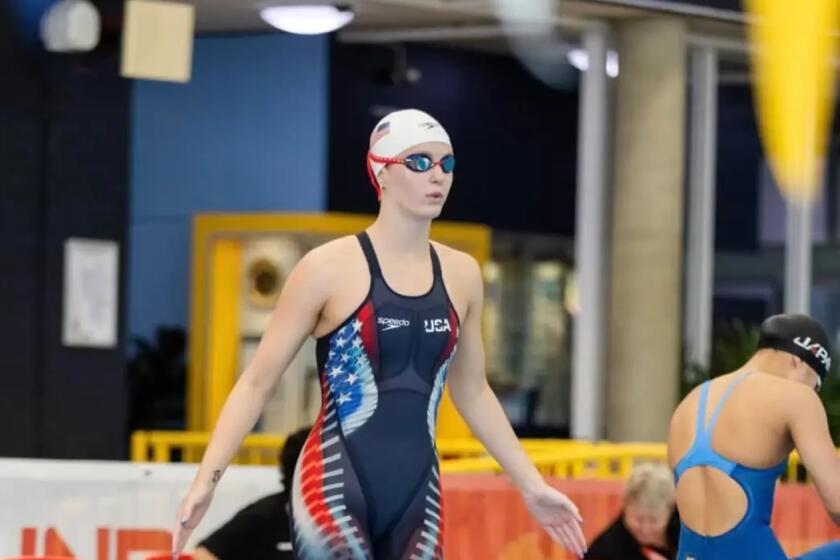Soccer’s original rules were made to be brokered, apparently
- Share via
Sea gulls, snails, bikinis and diamonds.
You have to wonder what the good folk in Sheffield, England, would have thought of soccer today. It wasn’t anything like this when they drew up the rules of the sport 153 years ago.
Certainly, Victorian eyebrows would have been raised to record highs.
Speaking of which, among the summer’s many odd and unusual happenings on and off the pitch was the sale at auction in London of soccer’s original rule book.
The handwritten tome was penned in 1858 by the founders of Sheffield FC, the world’s oldest soccer club. The team still exists but to ensure its financial survival it had to put its most treasured possession up for sale at Sotheby’s.
The rule book — which states that teams should be made up of 20 players apiece, that games should last two hours and that handling, but not carrying, the ball should be permitted — fetched $1.42 million.
Before the book went under the hammer, Richard Tims, Sheffield FC’s chairman, said it was a difficult decision to part with the item but that, “If you are looking for a piece of footballing history, this is the ultimate prize.”
Possibly so, but another item of soccer interest fetched more than six times as much when it was auctioned at Christies in London.
“The Football Match,” a 1949 painting by the late English artist L.S. Lowry that originally sold for about $400, was snapped up by an unknown bidder for $9.2 million.
The work, in the words of the BBC, “depicts hundreds of his famous stick figures gathered at a match against a backdrop of factories and billowing chimneys.”
Philip Harley, a Christies director, told the BBC that the painting “perfectly captures the spirit and drama of a town gripped by the excitement of the Saturday football match.”
Lowry was from Manchester and was a lifelong fan of Manchester City, which means it was unlikely that Manchester United’s Wayne Rooney was the winning bidder.
But Rooney did make auction news elsewhere.
At the end of last season, Eddie Maxwell, a savvy Blackburn Rovers fan, got permission from the club to dig up the penalty spot from which Rooney had scored the goal that clinched the 2011 title for Manchester United.
Maxwell put the bit of sod on eBay to help fund his local amateur team and was rewarded with a winning bid of $9,934. “For a football team of our grass-roots level [that] is absolutely brilliant,” Maxwell said.
There were equally strange doing at England’s lower-division clubs.
Equally brilliant, but in an entirely different manner, was the practical joke played by construction workers who were putting the finishing touches to Brighton and Hove Albion’s new stadium.
The club’s nickname is the Seagulls and the blue and white seats in one bloc were supposed to be arranged to show a sea gull in flight. Instead, the workers rearranged the seats to show the bird doing what sea gulls the world over do — making deposits from on high.
The prank was well received, but quickly corrected.
While on the subject of animals, it should be noted that former Watford goalkeeper Lloyd Scott, who now raises millions for charity, took 26 days to complete the London Marathon while dressed as a snail.
Not to be outdone, Port Vale fan Dave Walker somehow managed to persuade Nicola Williams, his bride-to-be, to walk down the aisle accompanied by Boomer the Dog, Port Vale’s mascot.
Meanwhile, Donny Dog, the mascot of Doncaster Rovers, was fired by the club after posing in lingerie for a children’s charity. Tracy Chandler, who inhabits the dog costume, got her job back after growls from fans.
Dwindling attendance at FC Rossiyanka, a championship-winning women’s team from Krasnoarmeysk near Moscow, has caused the club to play not in lingerie but in bikinis.
Baring all is what the male players of Valencia in Spain did, running out of the locker room and onto the field naked for a television advertisement designed to showcase their new shirt sponsor.
Werder Bremen in Germany did not go that far, but the Bundesliga club has banned its players from getting tattooed during the season because of the risk of infection that would cause them to miss games.
Players being players means that there will always be bling of some sort being flaunted.
Take the case of Tottenham Hotspurs’ Croatian international defender Vedran Corluka, who apparently is wealthy enough to have swapped watches with a waiter at a London nightclub.
The waiter admired Corluka’s wrist wear and was stunned when the player agreed to take the waiter’s $244 timepiece in exchange for Corluka’s $58,000, diamond-encrusted watch.
Wearing jewelry on the field is not permitted, of course, all of which brings us to the bizarre case of Aaron Eccleston, a player for Old Hill Wanderers, near Melbourne, Australia.
Struck in the groin by a hard shot, he lowered his shorts on the sideline to check the damage done. That’s when an overly curious referee noticed Eccleston’s genital piercing and ejected him from the game.
That sort of thing wasn’t covered in that 1858 rule book.
More to Read
Go beyond the scoreboard
Get the latest on L.A.'s teams in the daily Sports Report newsletter.
You may occasionally receive promotional content from the Los Angeles Times.










